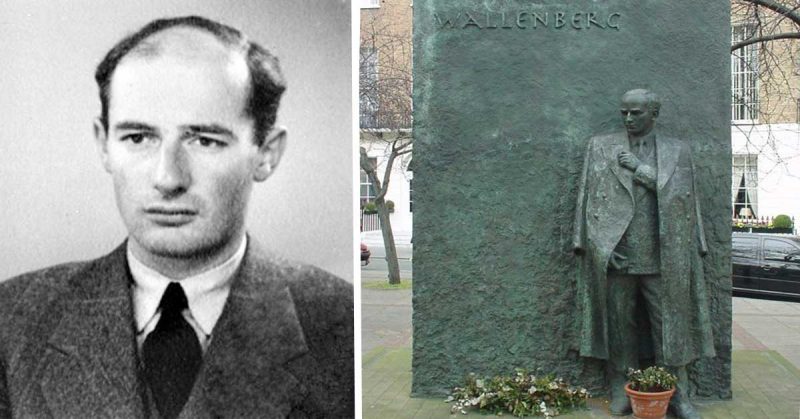Raoul Wallenberg, who disappeared from Budapest in 1945, was a Swedish diplomat who was proud of his one-sixteenth Jewish heritage. He more than proved this attachment, during the WWII Nazi occupation of Hungary, he braved grave dangers while working to save as many Jews as he could, from certain death.
Raoul Gustaf Wallenberg was born on 4 August 1912 to Swedish parents. After completing his high school education and his Swedish military duty, he studied in Paris then the United States. He graduated from the University of Michigan, worked in South Africa and in Haifa for short periods and then, in 1939, joined the Central European Trading Company in Stockholm, which was owned by Kálmán Lauer, a Hungarian Jew.
As Hungarian laws restricted Jews, Raoul traveled to Hungary on Lauer’s behalf, often to Budapest, then later also to Germany and to Occupied France during the early years of the war. His observations regarding Nazi bureaucracy and administration were eventually to be most valuable to him.
As the war progressed, and following the horrendous 1944 April/ May mass deportation by the Nazis of Hungary’s Jews to extermination camps, (at a rate of 12,000 individuals per day), many countries sought ways to aid the Jews. They needed an appropriate person to send to Budapest, under diplomatic cover. Raoul fitted the requirements and was appointed to lead the rescue mission.
Reaching the Swedish legation in Budapest in July, Raoul found that there were only 230,000 Jews left in the city. He and a fellow diplomat at once set about issuing Swedish passport papers identifying the bearers as Swedish subjects awaiting repatriation – so that they could not be deported. He was also involved in the successful negotiating with German authorities, resulting in over 9000 passes being honored. Raoul rented more than 30 buildings within Budapest, conspicuously hanging the Swedish flag and clear signage (for example – The Swedish Library or Swedish research center) – to ‘advertise’ that this was Swedish territory and thus protected by diplomatic immunity. These various buildings eventually housed over 10,000 people.
An eyewitness told of Raoul’s feat of getting onto a roof of a trainload of Jews about to leave for Auschwitz, and handing out passports. He then ordered all those who had one to leave the train and get into the Swedish-marked cars parked nearby, thereby saving dozens of Jewish people from certain death. Another report tells how Raoul bribed some Germans to prevent the blowing up of a ghetto, thereby saving an estimated 70,000 Jews. He also managed to cancel a death march planned for the remaining Jews of Budapest by threatening to have those responsible prosecuted for war crimes once the war was over.
Budapest had been taken over by Soviet forces when Raoul was summoned to the Soviet military headquarters, of Debrecen, just east of Budapest, on 17th January 1945. He is reported to have said that he was not sure whether he was to be a guest or a prisoner. It seems that he was indeed imprisoned and soon after, disappeared under mysterious circumstances.
Over 71 years later, he has finally been pronounced dead by the Swedish authorities. Officially listed as a missing person, in spite of little hope his being alive, the Swedish Tax Agency, (which registers births and deaths), on 26th October 2016, confirmed that Wallenberg had been pronounced dead. The date of his death has been set on July 31, 1952, five years after his disappearance.
There are many stories regarding what happened to Raoul after his detention and many witnesses who claimed to have met him during his imprisonment. What is seen to be most likely is that after he was imprisoned he was taken by train to Moscow and in January 1945, transferred to Lubyanka prison. There are a number of stories circulating with regard to his being imprisoned, due to the percieved strong likelihood of his being involved in espionage for the United States. A fellow prisoner in Lubyanka, Gustav Richter, testified that Raoul had been interrogated in February 1945, but in March, Richter was moved from his cell, and never saw Raoul again.
Later that March, Hungarian radio, (Soviet controlled at the time), announced that Raoul and his driver had been murdered on their way to the town where he was first imprisoned, but the confusion continued, for in February 1957 the Soviet government released a document dated 17 July 1947, which stated that Raoul had “died suddenly in his cell this night, probably as a result of a heart attack or heart failure.” In 1991, Vyacheslav Nikonov carried out a thorough investigation into the fate of Raoul and came to the conclusion that he had been executed while a prisoner in Lubyanka, in 1947.
Because of his selfless bravery, Raoul had received numerous humanitarian honors during the time he was officially “missing.” He was honored by the United States by being awarded one of the only two Honorary Citizens of the United States. He was similarly honored by receiving citizenship of Canada, Hungary, Australia and Israel. Israel honored him still further, by designating him as being one of the Righteous Among the Nations – the highest honor granted to non-Jews who risked their lives to save Jews during the Holocaust, CBS News reported.
Raoul has had monuments dedicated to his memory, streets named after him and has even had stamps issued in his honor in a number of countries. On 26 July 2012, he was recognized yet again by the US, for Congress awarded him a Congressional Gold Medal “in recognition of his achievements and heroic actions during the Holocaust.”
Raoul Wallenberg, in his service to humanity, deserved all these awards – he was a great man.
